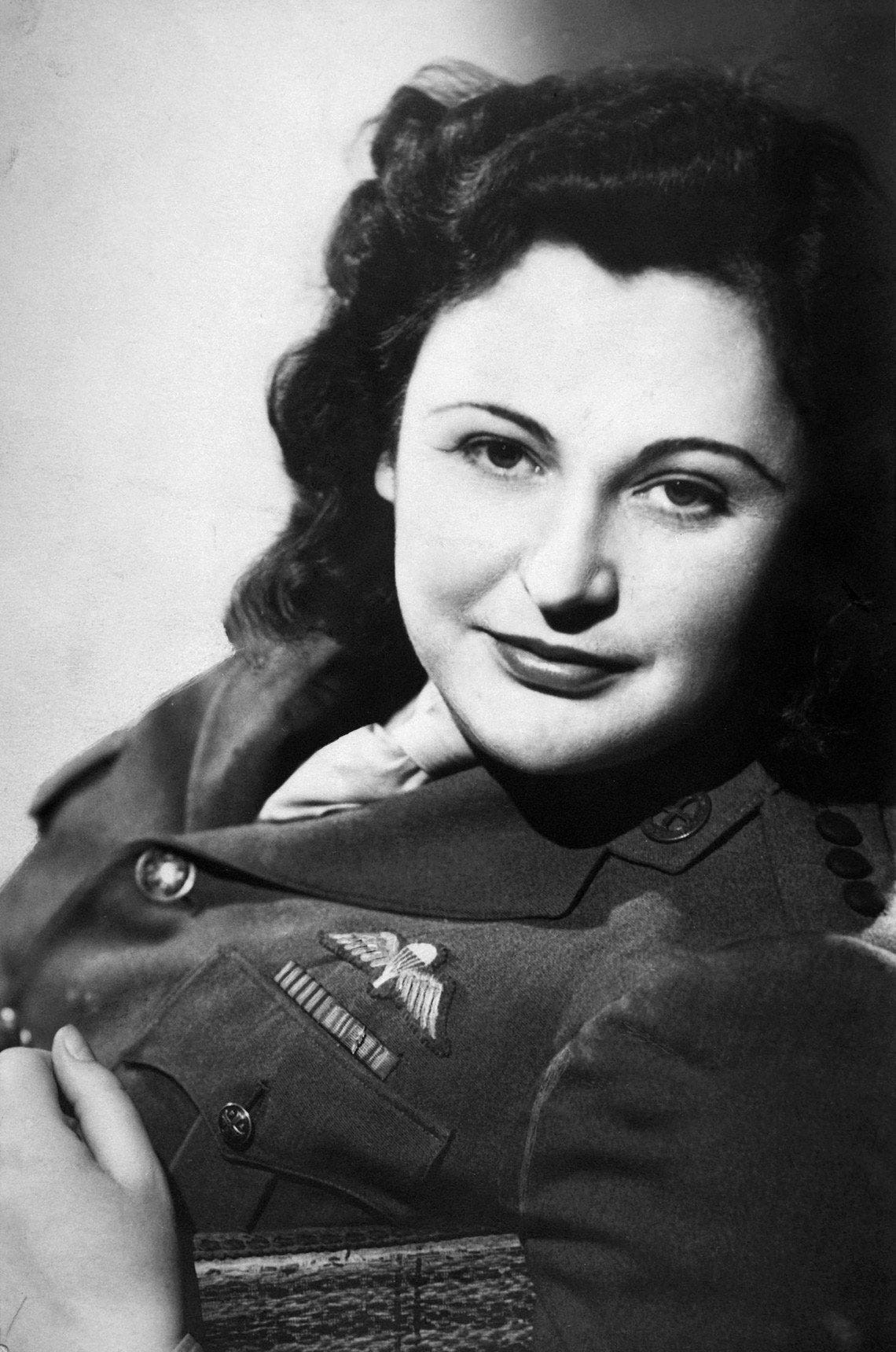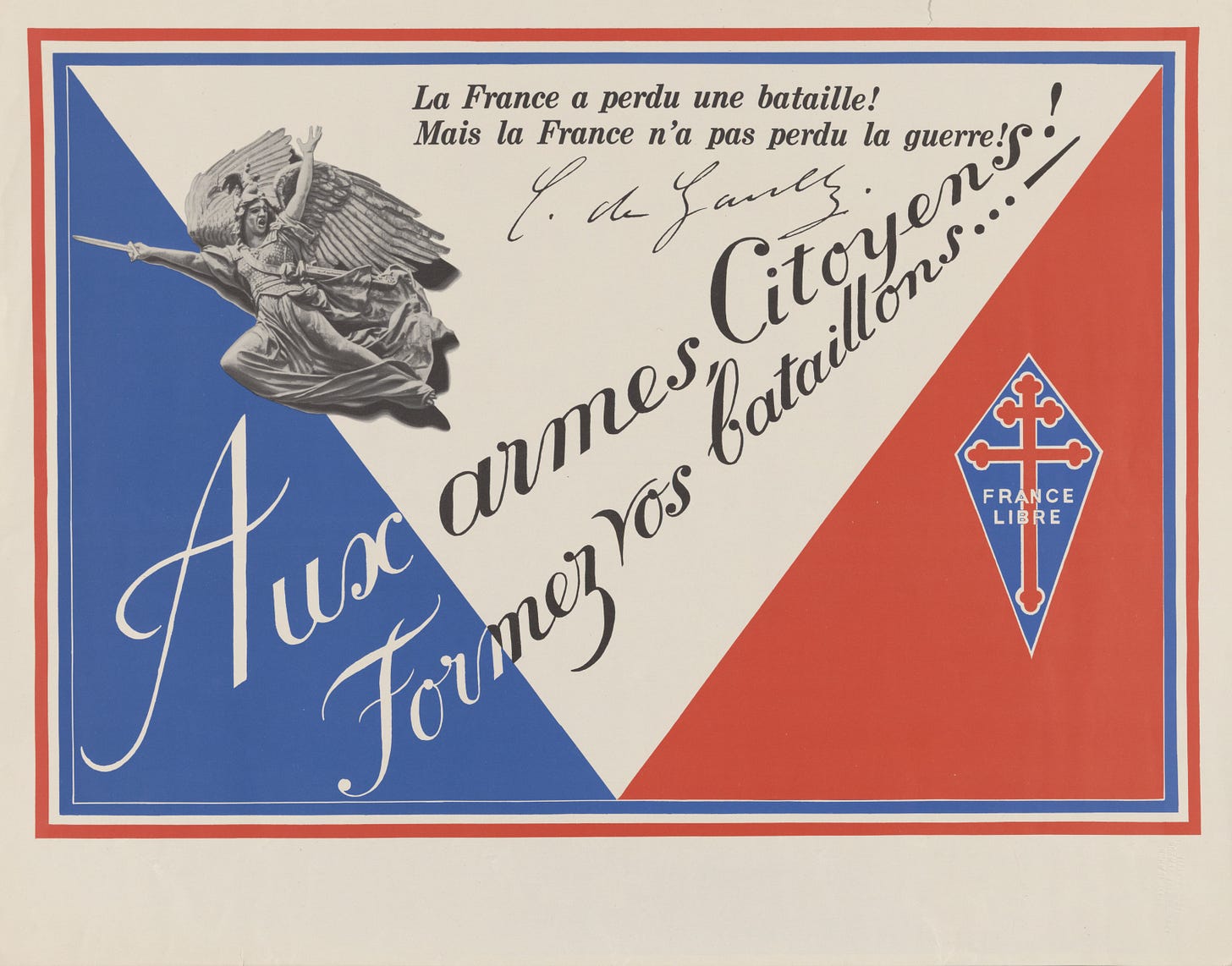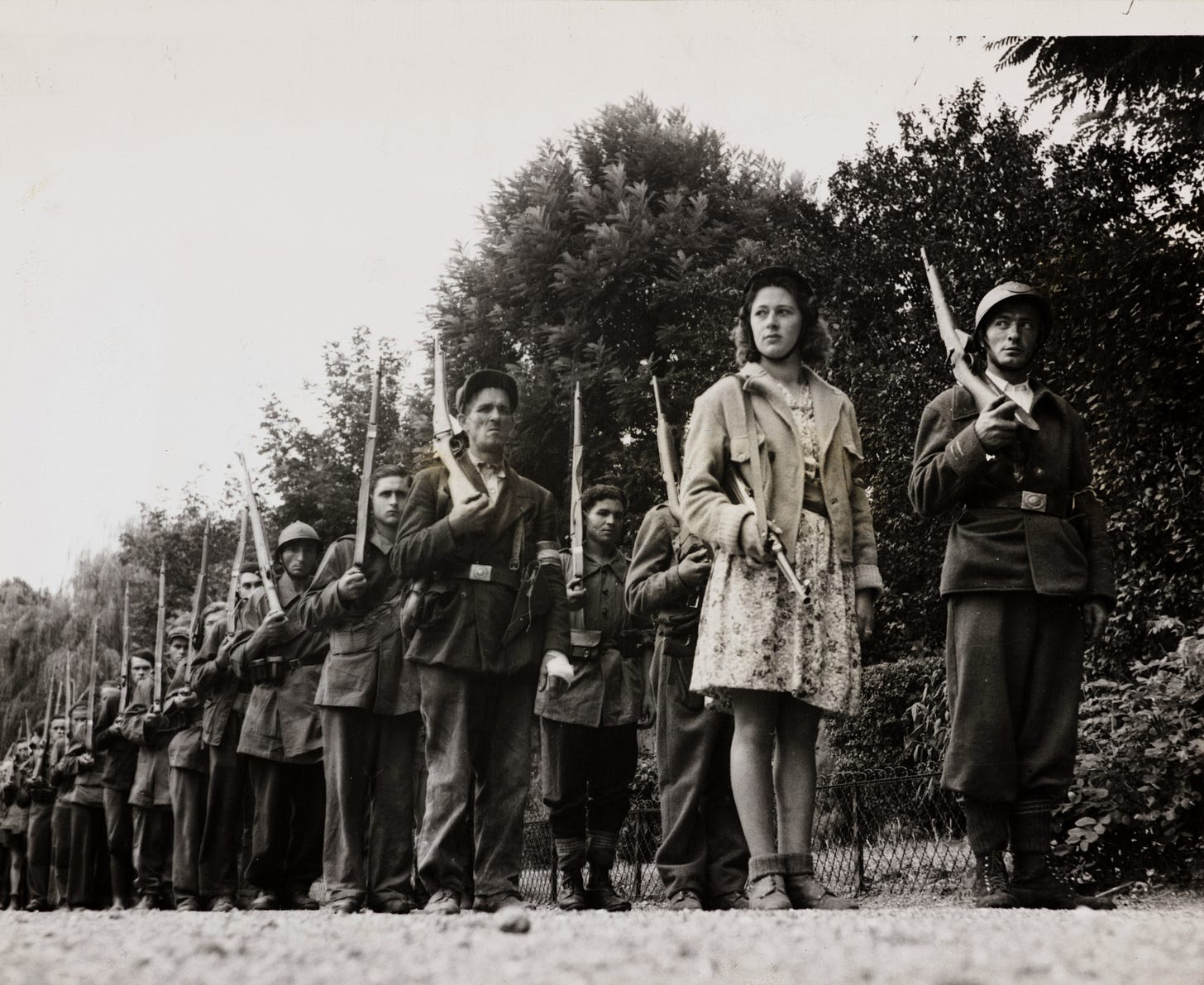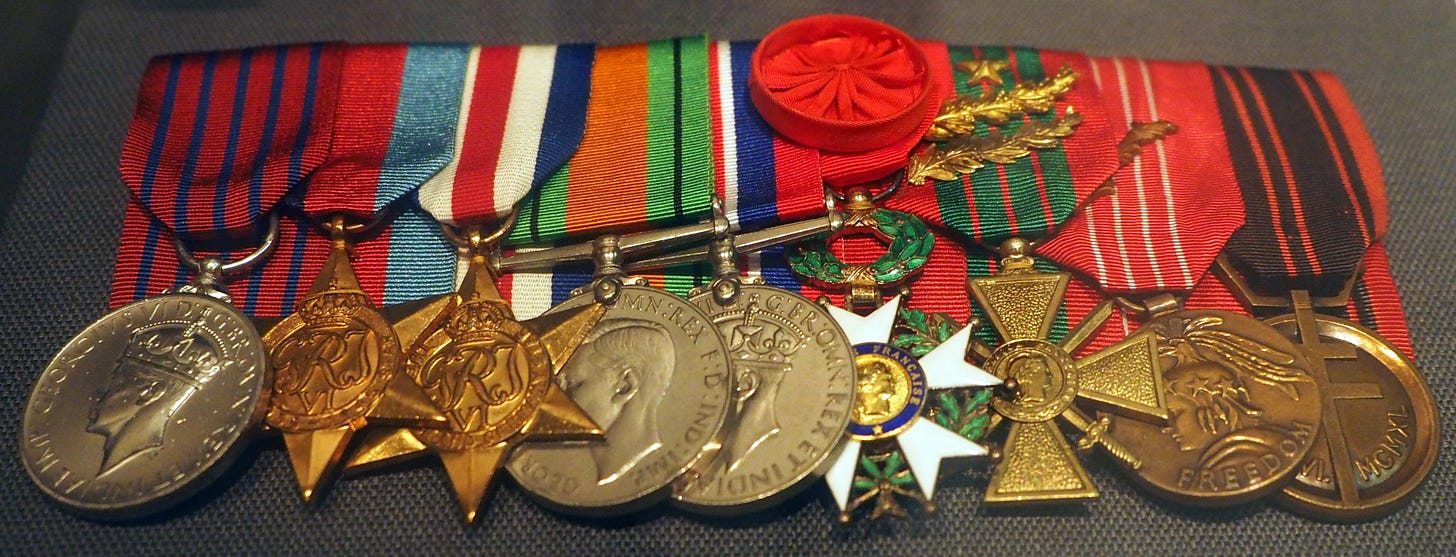
February 1944
Nancy Wake huddled in the belly of a Liberator bomber, puking her guts out as she soared high above the drop zone.
It was a dangerous time. The outcome of World War II hung in the balance, and Wake was about to parachute into the most perilous place on Earth, Nazi-occupied France.
The ride was bumpy, and she knew better than to accept the Spam sandwich the friendly American copilot offered. But she was famished and needed to keep her strength up. Now she was paying the price. Or maybe she owed her misery to the three bottles of wine she shared with the boys the night before.
Huge bonfires blazed in the darkness below. Who had lit them, the Resistance or the Germans?
She was dressed for the job—overalls with revolvers in the pockets, bulky camelhair coat, parachute, webbing harness, and helmet. Beneath it all, she wore civilian clothes, complete with high heels and silk stockings. She also carried a frumpy handbag stuffed full of cash and secret instructions for D-Day.
This was Wake’s long-awaited return to France. Already, she had orchestrated the escape of hundreds from the deadly grasp of the Nazis—downed Allied airmen, Jewish refugees, targeted civilians, and members of the Resistance. Finally, France became too dangerous for her, and she had to escape.
Now she was back. As she leapt from the plane and plunged into the cold darkness, she knew her survival was far from certain.
Nancy Wake Goes to War
Born in New Zealand and raised in Australia, Nancy Wake was in Paris, working as a foreign correspondent for Hearst Newspapers, when Adolf Hitler came to power in Germany in 1933. Rumors about the Nazis were running rampant, and Wake decided to see for herself what they were all about.
She and a photographer colleague travelled to Vienna, where they witnessed Jews being tormented and abused in the streets by Nazi-sympathizing thugs. She was especially horrified to see a Brown Shirt beating an elderly Jew with a whip.
That’s where Wake’s war started. She vowed she would do whatever she could to fight such an evil regime.
She got her chance when Germany invaded France in 1940. By this time, Wake was living comfortably in Marseille, married to wealthy French industrialist Henri Fiocca. But she couldn’t stand idly by with Nazi troops goose-stepping through her adopted country.
France was woefully short of ambulances to evacuate wounded soldiers, and Wake persuaded her husband to buy an ambulance for her to drive. When Henri was called up to the army, Nancy joined a volunteer medical evacuation unit.
In the massive chaos of the French defeat, she and her little unit were able to do little. But she remained steadfast in her early opinion of the Nazis as she watched them brutally annihilate the French army and strafe civilian refugees on the roads.
The White Mouse
Even though France capitulated, Nancy and Henri, back from the army, weren’t done fighting.
While Henri supplied money for the French Resistance, Nancy played a critical role with a British-run escape network, smuggling hundreds of people out of France and into neutral Spain. They were downed Allied airmen, Jewish refugees, political dissidents, compromised Resistance members, and others who faced certain death at the hands of the Nazis.
Able to pass as a native Frenchwoman, she eluded the Nazis at every turn, donning disguises, forging documents, navigating enemy checkpoints, avoiding surveillance, and gathering intelligence.
Attractive, feisty, and flirtatious, she fooled the Gestapo through charm and wit. She often got into trouble, flirting or talking her way out of it every time.
The Gestapo called their elusive quarry “The White Mouse” and placed a five-million-franc bounty on her head.
By 1943, the pressure on Wake was unbearable. To avoid capture, she trekked over the Pyrenees to Spain, as she had helped so many others do.
Henri stayed behind and was arrested by the Nazis.
Back in France
On that dark February night in 1944, Wake heard footsteps as she dangled several feet off the ground, her parachute caught in a tree.
It was a Frenchman. “I hope all the trees in France bear such beautiful fruit this year,” he said.
“Don’t give me any of that French shit,” Wake replied. She knew how Frenchmen operated. She was married to one and had lived in France for 10 years.
The gallant Frenchman’s name was Henri Tardivat, an important Maquis guerrilla commander in the Auvergne region of central France. Together, they would become the bane of the occupying Nazis.

Wake had been trained by Britain’s SOE (Special Operations Executive) to bury her parachute upon landing. Tardivat wouldn’t allow it and folded the canopy to carry it away. Later, Wake would be grateful to have the smooth nylon sheets to sleep under while she eluded the Nazis in the French woods.
Following Wake’s escape to Spain, she had made her way to London, where she immediately approached Charles de Gaulle’s Free French to get back in the war.
They rejected her, despite her extensive experience with clandestine operations and intimate knowledge of the French language, culture, and countryside.
The reasons were complicated, mired in political rivalries existing among various factions of the Free French forces, the French distrust of women in combat, Wake’s previous involvement with the British, and her outsider status as an Australian.
They didn’t like me because I was a woman, and I did things better than most of their men.
Nancy Wake
The British, however, seized the opportunity and recruited Wake for the SOE. Soon, she was in Scotland training in parachute jumping, hand-to-hand combat, weapons, sabotage, and espionage.
She excelled in all aspects of her training—able to “put the men to shame,” according to her SOE superiors. The White Mouse was on her way back to France.

Her mission was to organize, arm, train, and finance French Resistance units so they could wreak havoc behind the lines when the Allies landed at Normandy on D-Day. In addition to her other duties, Wake operated as second-in-command of a force of 7,500 Resistance fighters.
On one occasion, the guerrillas liberated three captured French women. When one proved to be a spy, the Frenchmen were reluctant to execute her. Wake grabbed a pistol and offered to do the job herself. One of the men relented and saved her from the task.

After one pitched battle, the Maquis lost their radio. Desperate to get a message to SOE, Wake bicycled 500 kilometers through enemy territory to find another radio and reestablish contact.
The feat took 72 hours of travel, day and night, across enemy checkpoints and mountain passes. Wake brazened her way through with courage, determination, and feminine charm.
Under Wake’s leadership, the Resistance audaciously attacked the Gestapo headquarters at Montluçon, destroying the building, killing high-ranking German officers, and shattering the morale of the occupiers.
On a raid against a German armory, Wake was surprised by an SS sentry. Rather than allow him to raise the alarm, she killed him with her bare hands.
They’d taught us this judo-chop stuff with the flat of the hand at SOE… But this was the only time I ever used it—whack—and it killed him all right. I was really surprised.”
Nancy Wake
Wake Proves Her Mettle
Resistance commanders were initially skeptical of Wake. She was from faraway Australia. She represented the mistrusted British. And above all, she was female. Time and again, she had to show them on their own terms that she was as tough as they were.
One local Maquis commander, whose name is lost to history, challenged Wake to a drinking match as a way of testing her nerve, mettle, and endurance. In his forest hideout, they downed glass after glass of local spirits until Wake drank the man under the table.
She is the most feminine woman I know, until the fighting starts. Then, she is like five men.
Maquis commander Henri Tardivat
The contest, of course, wasn’t about drinking. It was about Wake proving she could match the hardened guerrilla fighters in toughness, resilience, and bravado, qualities that meant more to them than credentials or formal rank.
After the War
Following the liberation of Marseille, Wake learned that her husband, Henri, had been tortured and killed by the Nazis in 1943 when he wouldn’t reveal her whereabouts.
In the 1950s and 60s, she split her time between Australia, where she ran unsuccessfully for public office, and England, where she worked for the Air Ministry and remarried.
After the death of her second husband, she emigrated permanently to England, taking residence at the Stafford Hotel, near Picadilly, a club for British and American Forces during the war. She became a fixture, staying until she was 90 at the expense of the hotel owners in honor of her wartime service.
Wake could usually be found in the hotel bar each morning, quaffing her first gin and tonic of the day.
She published her autobiography, The White Mouse, in 1985. The bestseller served as the inspiration for several British and Australian TV mini-series and docu-dramas.
The heroic Nancy Wake died on August 7, 2011, at the age of 98.
Honors
The British, French, and Americans showered Wake with medals and honors—but, strangely, her native Australia did not. Decades later, the Australian government offered to bestow medals, but Wake refused, believing such a long-delayed honor to be hypocritical.
I told the government they could stick their medals where the monkey stuck his nuts.
Nancy Wake
In 2004, when Wake was 91, the Australian government made her a Companion of the Order of Australia. Two years later, New Zealand awarded her the RSA Badge of Gold.

References:
Lawhon, Ariel. Code Name Hélène, Doubleday Books, 2020.
Wake, Nancy. The White Mouse—The Autobiography of the Woman the Gestapo Called the White Mouse. Macmillan, 1985.
Nancy Wake - Alchetron, The Free Social Encyclopedia
Nancy Wake, The White Mouse of the French Resistance
Also see:
Author’s note: I write historical novels. The Golden Girl and The Silver Screen Girl, tales of Hollywood in the Silent Era, are under contract. Shadow of the Dragon and Girl on the Wing are coming soon. My other books are available on Amazon. Visit my website and Substack page to learn more.
A version of this story also appeared in Medium.


